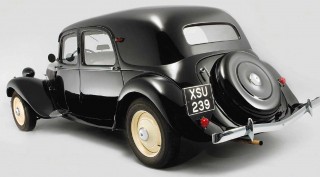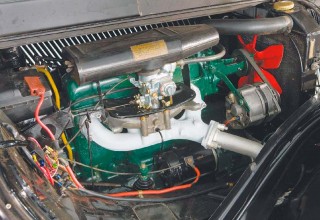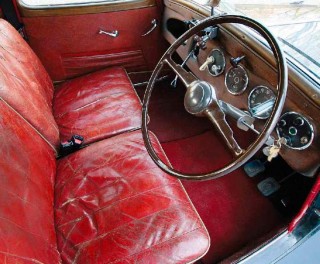BUYING GUIDE CITROEN TRACTION AVANT 1934-1956
WHICH ONE?
The most basic division in the world of Traction Avants is between the cars built in France and those built at Citroen’s plant in Slough. Slough-built cars are mechanically and structurally identical, but had some differences to suit British tastes and customs rules. The former were accounted for by leather seats and a wooden dashboard, while the latter led to the fitment of Lucas electrical parts and Girling brake components. Slough-built cars can easily be identified by the big chevrons of the Citroen logo being mounted behind the grille rather than in front of it. There is a further division: Traction aficionados prefer the pre-1952 small-boot (‘malle plate’) cars over the later big-boot (‘malle bombe’) versions and this is reflected in the values.

By far the most common Traction model is a four-door, four-light saloon with a 1.9-litre four-cylinder engine, in France this was designated an 11CV model, while in the UK it was rated at 15HP under our RAC system. Regardless, this model was available in two forms – the Citroen 11CV Ligere (or Light 15 in Slough-speak) and the Citroen 11CV Normale (Big 15). The Ligere had a 115in wheelbase, white the Normale clocked in at 122 inches and was also wider in both body and track giving much more space in the cabin, especially in the rear. The Normale/Big 15 is the more common of the two.
The Traction had been launched in April 1934 in 7CV form with an inadequate 1.3-litre engine, which had been quickly updated to a 9CV 1.5-litre and then a 1.6-litre unit before the much better 11CV model was brought in for December. Citroen continued to offer the 1.6-litre engine in the Ligere body (the model was, confusingly, still called the 7CV) until 1944, but few were sold.
The Normale-type body on the 122in wheelbase was also available with a 2.9-litre straight six engine, creating what the French knew as the 16CV (although Citroen officially called it the 15/6) and what to British buyers was the Big Six, Two specialist versions of the Traction were built in France with six-light bodies on a whopping 129in wheelbase. These were the nine-seater Familiale (with a folding central row of seats) and the hatchback Commerciale with a removable rear seat. The Familiale could be had with 11CV or six-cylinder power units, while the Commerciale was four-pot only. These were niche models (under 1000 Familiales were built in total) and survivors are both rare and desirable. Pre-war, Citroen offered two-door coupe and cabriolet Tractions in both four- and six-cylinder form and built on both sides of the Channel. These were always sold in small numbers and survivors are also both very rare and very expensive. You can count some surviving specifications (such as six-cylinder Slough-built coupes) on one hand – with fingers to spare!
Finally, for a single year from 1954, French Traction buyers had the option of the 15H, which was a Normale with hydropneumatic self-levelling suspension on its rear axle as a trial for the upcoming DS model. These are also very rare and highly desirable.
BODY
Like many early unitary-construction cars (and they don’t come much earlier than a Traction), the big Citroen was distinctly over-built, with the result that they are fairly resistant to corrosion, any rust tending to be confined to a few well-known places.

Slough-built cars have proven to be more rust-prone than French cars, not least because British Tractions had the widely-fitted option of a sliding metal sunroof which is a good breeding ground for rust, even without the drain holes getting clogged (which they inevitably do) thus allowing water to collect and then drip into the cabin. Slough cars also had UK-type trafficator arms fitted in their 8-pillars which is another entry-point for water and damp. Note that on all Tractions the roof centre section is a separate panel to the rest of the structure, with a visible seam that makes it look like a blanked-off sunroof – this is not the case. Many restored cars will have had the seam lead-loaded and painted over, so this is a good ‘tell’ as to the originality of a car, or the fastidiousness of a restoration.
Most of the Traction’s structural strength is in its sills, which are hefty three- part items (inner and outer, with ribs in between) and the floor, which is corrugated. Check all along the sill on both sides as thoroughly as you can and be aware that any visible rust on the outer sill (or signs of patches or replacement sections) almost certainly means there is worse corrosion inside. Look for signs of the doors scraping on the sills or binding on the latches, which might mean that the body has deformed due to rust, even if it has been patched and repaired.
Inspect the area around the rear of the sill and the base of the C-pillar, as this is where the rear suspension attaches to the body. At the other end of the car, check the door and bonnet shut lines and inspect the A-pil!ar and bulkhead for signs of deformation which would indicate that the body has lost its strength and is bending under the weight of the drivetrain. Also look at the body extensions that run beneath the bonnet and behind the front wings for signs of damage caused either by corrosion or accidents.
Lifting the bonnet(s) lets you see the engine bay side of the bulkhead and the front subframe mounts. The back tip of the front wings have an overlapping seam where the two skins of the wing are wrapped around each other, which is another breeding ground for rust. Many Tractions have kick-plates or mudflaps fitted here which can hide eaten-away metal.
The front floorpan can also rust out, compromising the monocoque. This is often due to the aforementioned sunroof drains on Slough cars and/or a perished sea! on the cabin vent flap in the scuttle panel. The boot floor rusts out if the boot seal perishes and/or the drain holes become blocked. Check too the lower parts of the door skins and frames.
The bonnets, front and rear wings, boot lid and doors are all bolt-on items on the Traction. Repair sections for common rust areas are easily available, but new wings are very expensive and have been for some time, so you may see cars with glassfibre reproductions.
ENGINE
The Traction’s engine is sturdy and suffers only generic wear and tear, while the Traction Owners’ Club can provide Traction-specific bits. On all but the very last Tractions the four-cylinder engines had old-fashioned white-metai bearings which are expensive to refurbish if worn, but many engines have been modernised with shell-type bearings from a late-model 11D engine. The 11D engine was also the only one to come with a proper oil filter – most Tractions rely on very frequent oil changes at 1500-mile intervals, so try and see evidence of this level of upkeep (or at the very least see that the oil in the engine looks fresh). No Traction had an oil pressure gauge or light as a standard fit either, so listen out for rumbling bearings or knocking big ends.

There was no timing chain tensioner, so some front-end rattle is normal, if it is excessive, replacement is an engine- out job since the engine sits ‘backwards’ in the engine bay. An aftermarket tensioner kit has been available for a few years and is a welcome addition.
The four-cylinder engine is mounted on steel volute springs. If these get tired, the engine rocks excessively at idle and can cause clutch judder and a loud knocking on the bulkhead when on the move. New volute springs and kits to fit conventional rubber mounts are available.
The six-cylinder engine isn’t quite as tough as the four-pot, but it is still far from troublesome. Neglect and age can cause head gasket problems or a warped cylinder head, so check for signs of the coolant and oil mixing or signs of weeping along the head/ block join. The starter ring gear on the flywheel can work loose, giving a gnashing sound when starting, while a rattle from the rear of the engine bay can mean that the crankshaft damper is working loose – this can cause serious damage if it breaks up or comes adrift.
TRANSMISSION
Gearbox problems are rare, other than worn-out synchromesh between top and second gear, but bear in mind that changing gear, up or down, in a Traction is never anything other than a leisurely business. If the car jumps out of gear when under way, this may mean the gearbox needs a rebuild (which is expensive), but it’s more likely to be that the clutch interlock which latches the gear lever in position when the clutch is raised needs adjustment, which is simple. The transmission should be quiet, or at best emit a smooth whirr. Whines, knocks or shrieks mean that the bearings or the gears themselves are worn. Rebuilding a Traction transmission is expensive, so unless the car is otherwise perfect or a very rare variant, it’s best to look elsewhere.
Due to the Traction Avant’s drivetrain layout, the water pump is right above the clutch and bellhousing. Leaks from the pump can cause the clutch release bearing to stick or seize, or even the clutch itself to jam. The release bearing will be somewhat noisy when the clutch pedal is depressed even when in good condition.
Listen for clacking sounds from worn drive shafts on full lock, and feel for binding driveshaft joints caused by seized or worn universal joints. Twist each part of each driveshaft in opposite directions to check for wear in the splines (also shown by lurching or knocking sounds when going on and off the power at low speeds in first gear). Check to see that the grease nipples for the driveshafts and joints look like they’ve been regularly attended to.
SUSPENSION, STEERING & BRAKES
The Traction Avant’s suspension is beautifully simple, consisting of torsion bars all round with metallastic bushes and a telescopic damper on each corner. There is little to go wrong here other than simple age, wear and tear. The torsion bars themselves very rarely sag and can be adjusted for height, so as long as the car is sitting level, focus on the condition of the bushes. The front bushes are easily visible once the front wheels are put on full lock.
Look for cracked or perished rubber. If the buyer will let you, get the front end of the car off the ground and rock and wiggle the wheels to check for play in the bushes – otherwise shown by wandery, vague steering (Tractions should sit absolutely rock-solid on the road; the over-used expression ‘like it’s on rails’ is very apt here) and knocking sounds from the suspension.
The rear bushes are harder to see, even with the rear end raised, but the audible and driving checks are the same. It’s quite possible to replace all the bushes, but it requires specialist equipment and is therefore expensive. Worn bushes are by no means a deal breaker, but if they’re in poor condition this should be reflected in the price. The Owners’ Club loans special tools (and other useful equipment) to members if you want to tackle this and other jobs yourself.
The steering on nearly all Tractions is rack and pinion and it is essentially trouble-free. The steering will always be quite weighty, but should be smooth and accurate with virtually no play. Normale and the ultra- long wheelbase models were available with optional power steering in the 1950s. While rarely found, this system gives little issue so long as the pipes and connections aren’t leaky, the pump doesn’t shriek or groan and there are no tight spots in the steering.
The brakes are drums on all corners with hydraulic action but no servo. Just make the usual checks for leaky pipes, cylinders and reservoirs and be aware of any thrumming or pulsing through the pedal showing warped or badly- corroded drums. The braking performance is adequate, especially for the more sedate four-cylinder models, but will need a good firm press on the pedal to get decent stopping power. A trial emergency stop should lock both the back wheels without any dragging to left or right. Unlike later big Citroens, the handbrake acts on the rear wheels and should hold the car well on even a steep gradient if the linkage is in good condition and adjustment.
INTERIOR & ELECTRICS
Most French cars have a single rather Art Deco-style combined speedo/ammeter/fuel gauge unit, while Slough cars have individual circular dials. The latter are Smiths or British Jaeger items and are easier and cheaper to repair or replace if there are any problems. Trim kits for the seats (in leather or cloth), door cards, carpets and headlining are all available for the more common Traction models, although the kits themselves are expensive, as is getting an upholsterer to fit them so a scruffy interior is a good bargaining point for an otherwise decent car. Check the headlining for signs of water leaks from the roof panel, especially on a car with a sunroof.

The British cars all have 12-volt electrical systems with Lucas components, which means parts can easily be found at any half-decent autojumbie. French Tractions originally had 6-volt systems with Ducellier parts which are harder to find, especially on this side of the Channel. Many French cars have been modernised to 12-volt electrics, which is worthwhile as it provides more reliable starting and opens up the possibility of additional equipment such as radios, lighting, heaters etc. Speaking of which, the Traction
Avant didn’t have a heater as such, but relied instead on a duct carrying warm air from behind the radiator. This provides minimal cabin heat and no real demisting, which can be a problem in the UK climate! Many, if not most, UK-based Tractions have been fitted with a proper heater of some sort, usually a classic Smiths ‘fug stirrer.’ Tractions either had no indicators, semaphores (on British cars) or French-style single red lamps on the C-pillar. Many cars will have had amber flashing indicators fitted to suit modern conditions, but check the wiring is to a good standard.
WHAT TO PAY?
As with the survival rate, there is a big variance in Traction values between the ‘standard- issue’ 1.9-litre saloon models and the much rarer other versions. ‘Big boot’ French-built 11CVs with left-hand drive can be found for four-figure sums if you buy with care (there are plenty of solid but slightly shabby-looking examples out there in the £8000 region), while stretching to a £12,000 budget will let you pick a very nice example indeed.
There is little difference in the values between otherwise equivalent Legere and Normale models, but post-1952 ‘big boot’ models are generally worth about 25% less than an otherwise identical ‘small boot’ model. Slough-built Light/Big 15s are rarer and so decent examples start at the £15,000 mark and go up to around £25,000, or a little more for the really good ones.
Six-cylinder cars – whether French or British-built – start at around £30,000 for good examples and go up towards £50,000 for the best. This is the same sort of budget you’d need if you really wanted a decent long-wheelbase Familiale or Commerciale model. A two-door example of those in good nick can be £50,000-£80,000, or even breaking into six figures for something really rare.
British-built cars had the front chevrons behind the radiator grille, but French ones had them in front.
Rack and pinion steering arrived as early as 1936, and marked a big improvement over the earlier box.
Slough-built cars got leather on the seats and circular dash gauges.
Four-cylinder engines are tougher than the six-cylinder units, but both types are generally rugged.
The monocoque construction allowed Citroen to make their new Traction Avant extremely low and sleek by the standards of the day.





